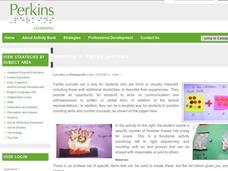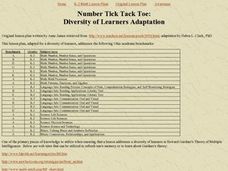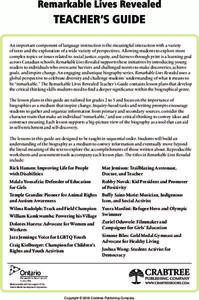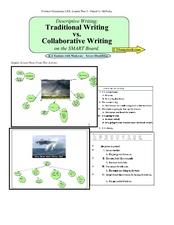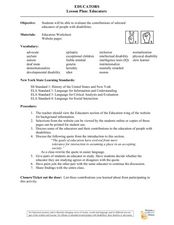Curated OER
Relationships, Day 4: Friendships & Dating
It is so important to help special needs individuals know the difference between dating and friendship. They define friendship, differentiate between friends and strangers, role-play, practice greetings, then talk about dating. This...
Perkins School for the Blind
Counting in Tactile Journals
This is one of those great ideas I totally love. Youngsters with visual impairments practice counting and left-to -right sequencing by counting out a set number of edible objects from the left and putting them in a bag on the right. They...
Perkins School for the Blind
The Printing Process
The printing process was a technological innovation that revolutionized the modern world. Your learners with visual impairments can experience this process by creating a print by using letterpress printing. They use cardboard, glue, and...
Perkins School for the Blind
I'm Thinking Of...
Learning how to describe an object or a person is a great way to develop verbal and written expression. Learners with special needs improve their verbal expressive skills and concept development skills while playing a guessing game. The...
Curated OER
Health Education: Self-Control
Third graders identify healthy methods of self-control. In this health lesson plan, 3rd graders take control of their own actions as they take part in a creative activity in which they learn healthy ways to monitor and control themselves.
Curated OER
Dance Tag
Students get moving instantly while reviewing already learned dance movements, the levels concept, and the self-space concept.
Curated OER
Shortenin' Bread Shuffle
Students learn a line dance that corresponds with the recreational dance curriculum of North Carolina. They respond to directional cues and terms in folk an line dancing.
Curated OER
SPORTS Lesson Plan: Trading Cards
After visiting websites about the Special Olympics, your class creates trading cards about people with disabilities and the adaptations that have been made for them in sports.
Curated OER
Physical Differences
Students role play what it would be like to have a physical disability. In this instructional activity on acceptance, students listen to the book A Rainbow of Friends by P.K. Hallinan. As a class, the students discuss similarities and...
Curated OER
Number Tick Tack Toe
Students participate in activities that apply Howard Gardner's theory of Multiple Intelligences in order to improve literacy skills. The lesson is ideal for diverse learners because of the application of the theory.
Curated OER
Characterization in Literature
High schoolers discover characterization techniques and methods. In this characterization lesson, students choose favorite fiction characters and discuss what makes a character come alive. High schoolers then describe a family member or...
Crabtree Publishing
Remarkable Lives Revealed
Six lessons make up a unit all about biographies. Scholars read about a remarkable life while taking notes and identifying characteristics of the biographical genre. Readers examine the tale's obstacles, accomplishments, and sequence of...
Curated OER
Parking Pass
Students look at the rights and laws created to assist individuals with physical disabilities. In this activity on fair treatment for all, students discuss symbols that related to people with disabilities. They create a new parking...
Curated OER
Traditional Writing vs. Collaborative Writing
Students examine language arts by completing a group activity. In this writing styles lesson, students define and discuss the differences between collaborative writing and traditional writing while answering questions in a Smart Board...
Curated OER
Running Out of Time: Picture Book Activity
Ease your class into reading Running Out of Time by first reading The Boy Who Stopped Time, a picture book with some similar concepts and themes. After a reading of the story, learners participate in a discussion and journaling exercise.
Curated OER
Reading Without Seeing: Louis Braille and the Braille Alphabet
Students study Louis Braille and the history of the Braille alphabet. They participate in an activity using the sense of touch to determine how the Braille alphabet works.
Curated OER
Words of Deep Meaning
Students create their own poems to express a deep feeling or transformative experience, then write imaginary letters to people in the article, responding to their poetry and sharing their own creative process.
Curated OER
Life Skill Communication
Students use digital camera to document the needs for daily living. In this life skills and visual arts activity, students create class books that include photographs of everyday objects that they use in their home, school and...
Curated OER
Creating Social Stories
Developmentally disabled pupils participate in the creation of their own social stories. They select a topic for their social story and work with the teacher to write a social story or create a video social story presentation.
Curated OER
Educators
After viewing selections from a website and discussing the role of the teacher in educating the disabled, students work in pairs. They analyze the work of an educator and relate the work to a given quote, then decide if that quote fits...
Curated OER
Let's Meet The Presidents
Create a digital movie documenting research about an American President. Using internet sources, students with special needs gather information about their chosen president. Working in groups, they use this information to create a...
Curated OER
Finding and Authenticating Online Information on Global Development Issues
Students discover how to find authoritative resources. In this research skills lesson, students examine strategies for using the Internet effectively to research global development issues.
Curated OER
Strategy Script #4
This lesson is designed for college students who are having anxiety regarding public speaking. In it, the speech givers go through a process of using imagery in order to reduce anxiety. The instructor guides the pupils in visualizing how...
Curated OER
Community Connections
Eighth graders with a number of disabilities visit people and places in their community while using digital cameras to record their visits. They take digital pictures which they include in books, posters, and other publications which...



